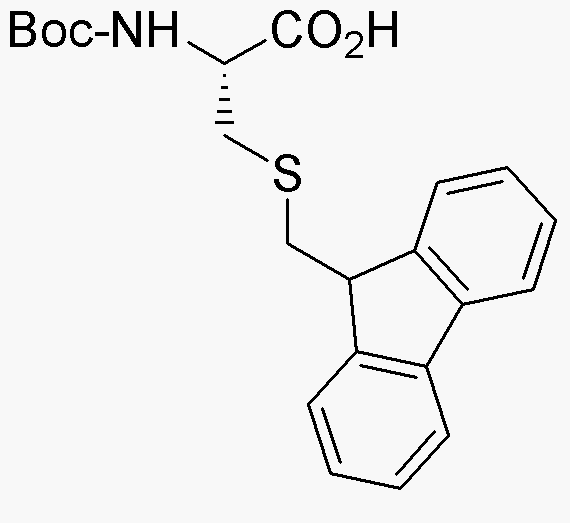Boc-S-9-fluorenylmethyl-L-cysteine is widely utilized in research focused on:
- Peptide Synthesis: This compound serves as a valuable building block in the synthesis of peptides, particularly those containing cysteine. Its protective group allows for selective reactions, enhancing the efficiency of peptide assembly.
- Drug Development: Researchers use this chemical in the development of new pharmaceuticals, especially in creating compounds that target specific biological pathways. Its unique structure can help in designing more effective drugs with fewer side effects.
- Bioconjugation: The compound is instrumental in bioconjugation processes, where it can facilitate the attachment of drugs or imaging agents to proteins or antibodies, improving the delivery and efficacy of therapeutic agents.
- Research in Protein Engineering: It is used in studies aimed at modifying proteins to enhance their stability or activity. This application is crucial in biotechnology and therapeutic protein production.
- Analytical Chemistry: The compound can be utilized in analytical methods to study the interactions of cysteine-containing peptides, providing insights into their behavior in biological systems.
General Information
Properties
Safety and Regulations
Applications
Boc-S-9-fluorenylmethyl-L-cysteine is widely utilized in research focused on:
- Peptide Synthesis: This compound serves as a valuable building block in the synthesis of peptides, particularly those containing cysteine. Its protective group allows for selective reactions, enhancing the efficiency of peptide assembly.
- Drug Development: Researchers use this chemical in the development of new pharmaceuticals, especially in creating compounds that target specific biological pathways. Its unique structure can help in designing more effective drugs with fewer side effects.
- Bioconjugation: The compound is instrumental in bioconjugation processes, where it can facilitate the attachment of drugs or imaging agents to proteins or antibodies, improving the delivery and efficacy of therapeutic agents.
- Research in Protein Engineering: It is used in studies aimed at modifying proteins to enhance their stability or activity. This application is crucial in biotechnology and therapeutic protein production.
- Analytical Chemistry: The compound can be utilized in analytical methods to study the interactions of cysteine-containing peptides, providing insights into their behavior in biological systems.
Documents
Safety Data Sheets (SDS)
The SDS provides comprehensive safety information on handling, storage, and disposal of the product.
Product Specification (PS)
The PS provides a comprehensive breakdown of the product’s properties, including chemical composition, physical state, purity, and storage requirements. It also details acceptable quality ranges and the product's intended applications.
Certificates of Analysis (COA)
Search for Certificates of Analysis (COA) by entering the products Lot Number. Lot and Batch Numbers can be found on a product’s label following the words ‘Lot’ or ‘Batch’.
*Catalog Number
*Lot Number
Certificates Of Origin (COO)
This COO confirms the country where the product was manufactured, and also details the materials and components used in it and whether it is derived from natural, synthetic, or other specific sources. This certificate may be required for customs, trade, and regulatory compliance.
*Catalog Number
*Lot Number
Safety Data Sheets (SDS)
The SDS provides comprehensive safety information on handling, storage, and disposal of the product.
DownloadProduct Specification (PS)
The PS provides a comprehensive breakdown of the product’s properties, including chemical composition, physical state, purity, and storage requirements. It also details acceptable quality ranges and the product's intended applications.
DownloadCertificates of Analysis (COA)
Search for Certificates of Analysis (COA) by entering the products Lot Number. Lot and Batch Numbers can be found on a product’s label following the words ‘Lot’ or ‘Batch’.
*Catalog Number
*Lot Number
Certificates Of Origin (COO)
This COO confirms the country where the product was manufactured, and also details the materials and components used in it and whether it is derived from natural, synthetic, or other specific sources. This certificate may be required for customs, trade, and regulatory compliance.


